The third in an interview series with participants in the 5th Frugivore and Seed Dispersal International Symposium.
Hornbills are one of Asia’s most attractive birds. Large, colorful, and easier to spot than most other birds, hornbills have become iconic animals in the tropical forests of Asia. Yet, most people probably don’t realize just how important hornbills are to the tropical forests they inhabit: as fruit-eaters, hornbills play a key role in dispersing the seeds of tropical trees, thereby keeping forests healthy and diverse. Yet, according to tropical ecologist and hornbill-expert Shumpei Kitamura, these beautiful forest engineers are threatened by everything from forest loss to hunting to the pet trade.
“Seed dispersal consists of the removal and deposition of seeds away from parent plants. Because seeds are not mobile, their movements must be facilitated by dispersal agents such as gravity, wind, water or animals. […] Even in central Southeast Asia where the wind- and gravity-dispersed family Dipterocarpaceae dominates the plant community, animal-dispersed plant species diversity is still high and most forest birds and mammals eat at least some fruits,” Kitamura explained to mongabay.com in an interview leading up to the 5th Frugivore and Seed Dispersal International Symposium where ecologists from around the globe will meet to discuss the importance of seed dispersers in the world’s embattled forests.
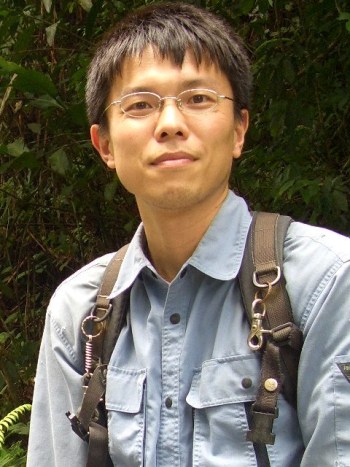 Shumpei Kitamura. Photo courtesy of Shumpei Kitamura. |
Hornbills are especially vital for Asia’s fragmented rainforests because they are “mobile link” species according to Kitamura. This means that because hornbills are capable of soaring over cleared forest areas or plantations, traveling from one forest patch to another to spread seeds across fragmented ecosystems. Other frugivore species—such as rodents and primates—are less likely to link forest fragments since they may find human-caused barriers more difficult to cross.
“Mobile link species are considerably important in the regeneration of ecosystems that have been disturbed by linking disturbed sites to undisturbed source areas where new organic material may be brought into the perturbed site,” Kitamura says, adding that “without thousands of animal species acting as seed dispersers, many plants would fail to reproduce successfully. Disruption of these complex services may leave large forest areas devoid of seedlings and younger age classes of trees, and thus unable to recover swiftly from human impact such as land clearing.”
Disruption to ecosystems doesn’t only occur by forest clearing, but also the loss of seed disperser species, such as hornbills. Kitamura points out that hornbill species are threatened by hunting for food; capture for the pet trade, including locals collecting chicks from a parents’ nest; as well as forest loss because the great birds “depend on forest trees for both food and nesting sites”. Forests in Thailand have been damaged by “the extraction of timbers, bamboo and other non-timber forest products from the forest, cattle grazing, encroachment and uncontrolled fires”.
Kitamura says that to help save Asia’s iconic hornbills, more research on the birds and their habitat is needed as well as increased conservation education for local communities, which “[play] an important role in enhancing awareness and appreciation of the natural resources and must be implemented at all levels.”
Kitamura and his colleagues have begun this process by setting up a program in southern Thailand called the Hornbill Nest Adoption Program, which Kitamura says “employs local people to observe the hornbills in the nests and collect scientific data about them.”
In an April 2010 interview mongabay.com spoke with Shumpei Kitamura about hornbills: their role as seed dispersers, the threats to their survival, and recommendations for conservation efforts.
INTERVIEW WITH SHUMPEI KITAMURA
Mongabay: What is your background?
Shumpei Kitamura: I am a plant ecologist and my main interests are within tropical ecology. I am particularly interested in plant-animal interactions in tropical forests of Southeast Asia. I focus on the role of large frugivores, especially hornbills, as seed dispersal agents and the impact of their loss in tropical forest ecosystems. As seed dispersers, hornbills help grow trees in their forest habitat: this means where there are hornbills, there should be relatively vigorous forest.
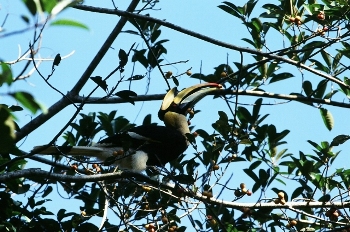 The great hornbill Buceros bicornis. Photo by: Shumpei Kitamura. |
I did my Masters in Khao Yai National Park in Thailand, working on interactions between fruit and frugivores at the community level in the tropical forest and my PhD focusing on the effectiveness of hornbills as seed dispersers for large-seeded tree species again in Khao Yai. My post-doc study focused on consequences of hornbill-loss in small isolated forests of southern Thailand and what happens to hornbill-dispersed fruits in these half-empty forests.
Mongabay: How did you become interested in hornbills?
Shumpei Kitamura: It was in August 1997, my first day in the tropical forest of Khao Yai National Park. I caught a glimpse of a huge, yellow-beaked bird perched on a tree branch. It was a great hornbill Buceros bicornis, one of the largest hornbills of the world. At that time, I participated in the third International Field Biology Course organized by DIWPA, Diversitas in the Western Pacific and Asia. Fieldwork in Khao Yai accompanied a lot of hard, repetitive work in the forest, but it was a brilliant experience to see one of Thailand’s most important protected areas and its wildlife including Hornbills, Asian Elephants, White-handed Gibbons, and Pig-tailed Macaques.
During the fieldwork in Khao Yai, I got a chance to talk with Dr. Pilai Poonswad, who has run long-term ecological research on hornbills throughout Thailand and also got interested in the role of hornbills as seed dispersers in tropical forest ecosystems. The next June, I got a chance to work with Pilai and her team, Thailand Hornbill Project in Khao Yai in which researchers had been investigating hornbill ecology (Hornbill Research Foundation) for many years. Since then I have been studying frugivory and seed dispersal by hornbills in tropical forests of Thailand.
Mongabay: What makes your study areas Khao Yai National Park, Budo-Sungai Padi National Park, and Hala-Bala wildlife sanctuary unique?
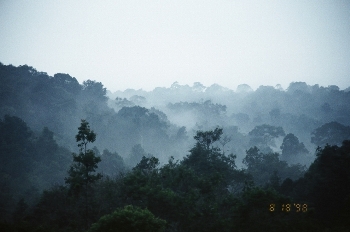 Khao Yai (“Big Mountain” in English) National Park. Photo by: Shumpei Kitamura. |
Shumpei Kitamura: My first study site, Khao Yai (“Big Mountain” in English) National Park, was established in 1962 and has been nominated as a UNESCO World Heritage site in 2005. It is an excellent place to see wildlife, for example Great, Oriental Pied and Wreathed hornbills are familiar and easily catch sight, and Brown hornbills can be found too. Since these hornbills require a large home range, a variety of fruits to feed on and cavities in big trees to nest, they are often said to serve as an indicator of the health of a forest.
Thailand Hornbill Project, led by Dr. Pilai Poonswad, has conducted ecological studies on sympatric hornbills in Khao Yai since 1980. Khao Yai is also famous for long-term ecological study on White-handed Gibbons, other important seed dispersers in Southeast Asia. Recently the gibbon team established the Mo Singto Forest Dynamics Plot (30ha) for the purpose of studying the woody plant community in detail and investigating the roles of gibbons and other frugivores on forest dynamics.
My second study sites, Budo-Sungai Padi National Park and Hala-Bala Wildlife Sanctuary, are located at the southern tips of Thailand, close to Malaysian border. Both study sites are included in Thailand’s more recent conservation areas and consist mainly of lowland dipterocarp forest, making them just about the only places in Thailand where many lowland Sundaic species can be found.
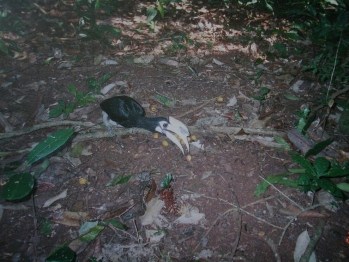 A hornbill caught on a camera-trap. Photo by: Shumpei Kitamura. |
Both protected areas are isolated from other forests by agricultural lands such as rubber plantation, fruit orchard and paddy field, but still support diverse species of hornbills: six species in Budo (Bushy-crested, Great, Helmeted, Rhinoceros, White-crowned and Wreathed Hornbills) and ten in Bala (Black, Bushy-crested, Great, Helmeted, Wrinkled, Oriental Pied, Plain-pouched, Rhinoceros, White-crowned and Wreathed Hornbills). A recent camera-trapping study reveals that the area still supports several large carnivores such as Asian Golden Cat, Clouded Leopard, Leopard and Tiger in Bala (Fig. 4).
SEED DISPERSING
Mongabay: Why is seed dispersal such an important component of tropical forest ecology?
Shumpei Kitamura: Seed dispersal consists of the removal and deposition of seeds away from parent plants. Because seeds are not mobile, their movements must be facilitated by dispersal agents such as gravity, wind, water or animals. Numerous plants in the tropics have seed-dispersal mechanisms that are associated with animals (Fig. 5). Therefore, fruit-frugivore interactions, in particular seed-dispersal processes, are considered to greatly affect plant demography in the tropics. Even in central Southeast Asia where the wind- and gravity-dispersed family Dipterocarpaceae dominates the plant community, animal-dispersed plant species diversity is still high and most forest birds and mammals eat at least some fruits. Consequently, the relationships between fruits and frugivores are extremely diverse, and both animal-dispersed plants and frugivorous animals are dominant within their respective groups in tropical forests.
Mongabay: How do seed dispersing-species help people?
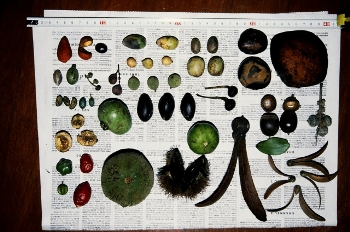 Tropical seeds that are dispersed by animals. Photo by: Shumpei Kitamura. |
Shumpei Kitamura: Seed dispersers such as hornbills have been classified as mobile link species. Mobile link species support essential ecosystem functions by moving actively or passively among green patches and ecosystems, connecting either different patch types or similar patch types with some kinds of “barrier” between them. Mobile link species are considerably important in the regeneration of ecosystems that have been disturbed by linking disturbed sites to undisturbed source areas where new organic material may be brought into the perturbed site.
Without thousands of animal species acting as seed dispersers, many plants would fail to reproduce successfully. Disruption of these complex services may leave large forest areas devoid of seedlings and younger age classes of trees, and thus unable to recover swiftly from human impact such as land clearing.
Mongabay: How have camera traps helped your studies of hornbills and other seed dispersers?
Shumpei Kitamura: In the study of wild animals, photographs not only provide confirmation of presence and identity, but also provide insights into species distribution, abundance, population dynamics and behavior. Camera trapping may be the most appropriate way for recording large, ground-dwelling mammals, but we have also unexpectedly recorded canopy-dwelling birds including hornbills on the ground for feeding fallen figs in Khao Yai.
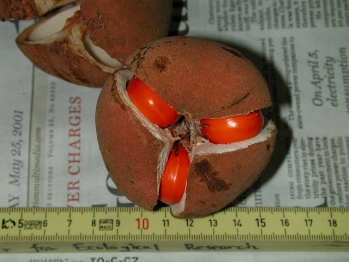 Dehiscent fruit with red aril is Aglaia spectabilis. Photo by: Shumpei Kitamura. |
Camera trapping is also ideal for identifying frugivory and seed dispersal by nocturnal animals on the ground in 24h base. By using this method, our team was able to observe what kinds of animals consume fallen fruits on the ground and quantify how many fruits were consumed by each animal species. Based on these data, we can estimate the fates of fallen fruits as well as those of hornbill-dispersed seeds on the forest floor.
HORNBILLS
Mongabay: You have discovered that hornbills are key species in dispersing some seeds of large and important trees. Why do you think hornbills are effective seed dispersers?
Shumpei Kitamura: In Khao Yai study, we focused on Aglaia spectabilis (Fig. 7) and Canarium euphyllum (Fig. 8) because both fruit species are known to be major diets for hornbills in their breeding (A. spectabilis) and the non-breeding season (C. euphyllum).
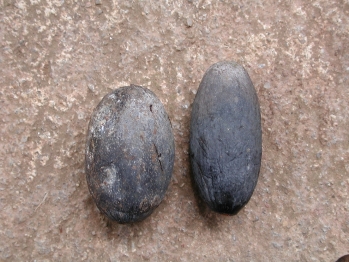 Black fruits are Canarium euphyllum. Photo by: Shumpei Kitamura. |
We assessed both the frugivore assemblages foraging on Aglaia spectabilis and Canarium euphyllum and dispersing them and the seed predator assemblages, thereby covering dispersal as well as the post-dispersal aspects such as seed predation. Our results showed that frugivores dispersing seeds were a rather limited set of four hornbill and one pigeon species (Mountain Imperial Pigeon), whereas two squirrel species (Black Giant Squirrel and Variable Squirrel) were not dispersers, but predated and/or dropped the seeds on the ground. Several mammal species such as Malayan Porcupine, Red Spiny Rat and Indochinese Ground Squirrel were identified as seed predators on the forest floor.
Heavy seed predation by mammals together with high seed removal rates, short visiting times and regurgitation of intact seeds by mainly hornbills lead us to the conclusion that hornbills show high effectiveness in dispersal of this tree species.
Mongabay: Can you tell us about the relationship between hornbills and small mammals in spreading seeds, such as rodents?
Shumpei Kitamura: After either being dispersed by hornbills or falling from a parent, seeds may be preyed upon or dispersed once again by secondary dispersers. Some seeds buried in caches are recovered and eaten later, but others may survive without being consumed. Of these secondary dispersers, small mammals, especially rodents, play a major role as seed predators and scatter-hoarding seed dispersal agents in the ecologies of almost all tropical habitats. However, the role of rodents as secondary dispersers is not well documented in Southeast Asia. In Khao Yai, by combining camera trapping and the thread marking method, we got an evidence of scatter-hoarding behavior of terrestrial rodents for Aglaia spectabilis and Canarium euphyllum.
The relative benefit of rodent scatter-hoarding to plants is likely to vary in space and time depending on a variety of conditions. Although we point out that seeds can become buried via the actions of other vertebrates, the potential of some seedlings for germinating from seeds buried by scatter-hoarding rodents cannot be ruled out. Given that major seed dispersers of large-seeded trees such as A. spectabilis and C. euphyllum are now absent or rare in degraded forests in Thailand as well as in tropical Asia, it is becoming increasingly important to understand the roles of scatter-hoarding rodents in these altered habitats in Southeast Asia.
Mongabay: How are Thailand’s hornbills faring? What is threatening them?
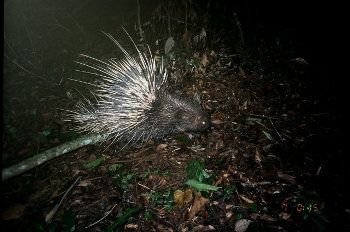 The Malayan porcupine. Photo by: Shumpei Kitamura. |
Shumpei Kitamura: There are several issues on hornbill conservation in Thailand. Many Thailand’s natural areas where hornbills inhabit are threatened or actively being degraded due to illegal hunting, the extraction of timbers, bamboo and other non-timber forest products from the forest, cattle grazing, encroachment and uncontrolled fires.
In certain areas, for example, hornbills had been extirpated by hunting. Hunting has been mainly for food securing by villagers who live near protected areas, but hunting for sale as pets is still going in some areas of Thailand. Therefore protected areas such as National Parks and Wildlife Sanctuaries can only partially prevent hunting but cannot assure full protection of all hornbill species.
Many national parks are surrounded by local villages whose residents tend to run out of forested land because much of it is clear-cut to make way for agricultural production. The resultant illegal poaching and logging in national parks have had a negative impact on endangered species including hornbills, elephants, and tigers.
These human disturbances not only directly affect the community structure of forests, but also may indirectly influence the frugivore community. This indirect influence is probably quite strong for Asian hornbills because they depend on forest trees for both food and nesting sites.
Although collection of chicks from the nests is a threat at Khao Yai and Hala-Bala, the greater distance from nesting sites to local villages affords the hornbills at these sites a greater level of security than in Budo Sungai-Padi. In Budo, several villages have relatively easy access to nesting locations and collection activities have presented a major threat to these populations.
Mongabay: What conservation measures would you suggest to protect hornbills and other important seed dispersers in Thailand?
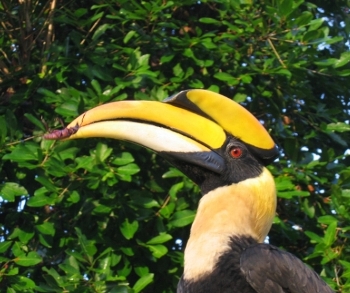 The great hornbill Buceros bicornis. Photo by: Shumpei Kitamura. |
Shumpei Kitamura: Intensive survey and study of threatened and endangered species are still required to ascertain the actual status, density, and potential of remaining habitats for these animals. However, even the basic natural history of most common vertebrate in tropical forests is largely unknown in Thailand. To bridge this information gap, a consistent and active conservation education program is required. Conservation education plays an important role in enhancing awareness and appreciation of the natural resources and must be implemented at all levels. To achieve this, more human resources in the field of ecology and/or conservation are needed.
Mongabay: How can the average readers help hornbills and other seed dispersers in Southeast Asia?
As for hornbills, besides collecting basic data of hornbill ecology, my colleagues in Thailand have coordinated and launched an interesting conservation program named Hornbill Nest Adoption Program in southern Thailand, which works to foster conservation of these hornbills. Illegal logging and the poaching of young birds for the pet trade are the key issues facing hornbills. The Nest Adoption Program employs local people to observe the hornbills in the nests and collect scientific data about them.
Related articles
Hunting, deforestation wipe out 6 of 7 hornbill species in Borneo park
(06/14/2008) Logging, forest conversion for palm oil, and hunting have triggered a precipitous drop in key wildlife populations in Malaysia’s Lambir Hills National Park, on the island of Borneo, said a biologist speaking at a scientific conference in Paramaribo, Suriname.
Seed dispersal in the face of climate change, an interview with Arndt Hampe

(04/05/2010) Without seed dispersal plants could not survive. Seed dispersal, i.e. birds spreading seeds or wind carrying seeds, means the mechanism by which a seed is moved from its parent tree to a new area; if fortunate the seed will sprout in its new resting place, produce a plant which will eventually seed, and the process will begin anew. But in the face of vast human changes—including deforestation, urbanization, agriculture, and pasture lands, as well as the rising specter of climate change, researchers wonder how plants will survive, let alone thrive, in the future?
(03/07/2010) There are few areas of research in tropical biology more exciting and more important than seed dispersal. Seed dispersal—the process by which seeds are spread from parent trees to new sprouting ground—underpins the ecology of forests worldwide. In temperate forests, seeds are often spread by wind and water, though sometimes by animals such as squirrels and birds. But in the tropics the emphasis is far heavier on the latter, as Dr. Pierre-Michel Forget explains to mongabay.com. “[In rainforests] a majority of plants, trees, lianas, epiphytes, and herbs, are dispersed by fruit-eating animals. […] As seed size varies from tiny seeds less than one millimetres to several centimetres in length or diameter, then, a variety of animals is required to disperse such a continuum and variety of seed size, the smaller being transported by ants and dung beetles, the larger swallowed by cassowary, tapir and elephant, for instance.”
Hunting across Southeast Asia weakens forests’ survival, An interview with Richard Corlett

(11/08/2009) A large flying fox eats a fruit ingesting its seeds. Flying over the tropical forests it eventually deposits the seeds at the base of another tree far from the first. One of these seeds takes root, sprouts, and in thirty years time a new tree waits for another flying fox to spread its speed. In the Southeast Asian tropics an astounding 80 percent of seeds are spread not by wind, but by animals: birds, bats, rodents, even elephants. But in a region where animals of all shapes and sizes are being wiped out by uncontrolled hunting and poaching—what will the forests of the future look like? This is the question that has long occupied Richard Corlett, professor of biological science at the National University of Singapore.
Priorities in global bird conservation ‘misplaced’
(08/10/2009) Bird conservation is misplacing its priorities by focusing on non-threatened bird species in developed countries, rather than threatened species from tropical nations, report researchers writing in Tropical Conservation Science.
